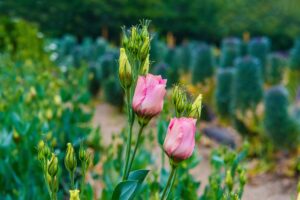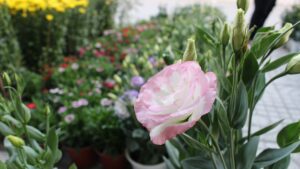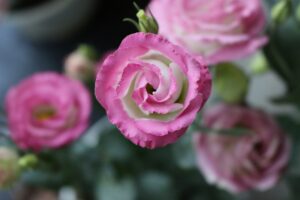Lisianthus flowers are characterized by their elegant and intricate appearance, resembling roses with their layered petals. The blossoms can be single or double, and they come in a variety of colors, including shades of white, pink, lavender, blue, and even bi-colored varieties. Lisianthus, scientifically known as Eustoma.
Lisianthus Plant Description
The petals of lisianthus flowers are often ruffled and may have a delicate, satin-like texture. Double-flowered varieties can have a fuller and more complex arrangement of petals, creating a lush and voluminous look. Lisianthus plants typically have long, slender stems that make them well-suited for cut flower arrangements. The foliage is green and can vary from narrow to broader leaves, depending on the specific species or cultivar.

Lisianthus blooms during the warmer months, generally from late spring through summer. However, the exact flowering season can depend on the specific climate and growing conditions. Lisianthus flowers are available in a wide range of colors, making them versatile for various floral designs. Common colors include white, pink, lavender, blue, purple, and sometimes bi-color combinations. The availability of different hues adds to the appeal of lisianthus in gardens and floral arrangements.
One of the notable features of lisianthus flowers is their long vase life. When used as cut flowers, they can last for an extended period, making them a popular choice for bouquets, centerpieces, and other floral displays.
Lisianthus thrives in well-drained soil and prefers full sun to partial shade. Adequate sunlight promotes robust growth and encourages abundant flowering. These plants are commonly grown in garden beds, borders, and containers.

Whether gracing a garden or enhancing a floral arrangement, lisianthus flowers bring a touch of elegance and sophistication with their exquisite blooms and versatile color palette.
Sunlight Requirement of Lisianthus flowers
Lisianthus plants generally prefer full sunlight. Plant them in a location where they receive at least 6 to 8 hours of direct sunlight each day for optimal growth and abundant flowering. While lisianthus can tolerate partial shade, they perform best in areas with plenty of sunlight. Lisianthus can also be grown indoors in containers. When grown indoors, place them near a sunny window where they can receive bright, indirect sunlight. Adequate light is essential for healthy indoor lisianthus.

Temperature and Humidity Requirement of Lisianthus Flower
Lisianthus plants thrive in moderately warm to mild temperatures. The ideal temperature range for growing lisianthus is between 60°F to 75°F (15°C to 24°C). Lisianthus appreciates cooler temperatures during the night, which helps promote flowering. Night temperatures in the range of 50°F to 60°F (10°C to 15°C) are beneficial. Lisianthus is sensitive to frost, and exposure to freezing temperatures can damage the plants. It’s essential to protect them from frost, especially during the colder months.

Lisianthus prefers moderate humidity levels. They can tolerate average humidity, but it’s crucial to avoid excessive moisture around the foliage, as this can lead to fungal issues.
Soil Requirements
The ideal soil pH for lisianthus is slightly acidic to neutral, ranging from 6.0 to 7.0. A loamy soil that is rich in organic matter is well-suited for lisianthus. Loamy soils provide a good balance of drainage, aeration, and nutrient retention. Incorporate organic matter such as well-rotted compost into the soil before planting.

Propagation of Lisianthus Flowers
Lisianthus can be propagated through both seeds and cuttings. Here are the methods for propagating lisianthus:
Propagation from Seeds
Lisianthus seeds can be sown directly in the garden or started indoors, depending on the growing conditions and preferences.
Start seeds indoors about 8 to 10 weeks before the last expected frost date in your area.
Sow the seeds on the soil surface, press them lightly into the soil, and keep them consistently moist until germination.
Once the seedlings have grown large enough and the threat of frost has passed, transplant them into the garden.
Space the plants according to their mature size, usually around 12 to 18 inches apart.
Direct Sowing
Lisianthus seeds can also be directly sown in the garden after the last frost.
Prepare a well-drained seedbed, sow the seeds, and cover them lightly with soil.
Keep the soil consistently moist until the seedlings are established.

Propagation from Cuttings
Lisianthus can be propagated from stem cuttings. Choose healthy, non-flowering stems for the cuttings. Each cutting should be around 4 to 6 inches long and taken from the tip of the stem.
Remove the lower leaves from the cutting, leaving only a few leaves at the top.
Dip the cut end in rooting hormone to encourage root development.
Plant the cuttings in a well-draining rooting medium.
Ensure that at least one node (where a leaf was attached) is below the soil surface.
Water the cuttings lightly and cover them with a plastic dome or place them in a plastic bag to create a humid environment.
Place the cuttings in a warm, bright location but avoid direct sunlight.
Keep the rooting medium consistently moist. After a few weeks, the cuttings should develop roots.
Once the cuttings have established roots, transplant them into individual pots or directly into the garden. Continue to care for them as you would for mature lisianthus plants.
Regardless of the propagation method chosen, providing a well-prepared and nutrient-rich growing medium, along with proper care and attention, will help ensure the success of lisianthus propagation.
Water Requirements of Lisianthus Flowers
Lisianthus prefers consistently moist soil, especially during the active growing season. Ensure that the soil doesn’t dry out completely between waterings. This is crucial for the development of healthy foliage and flowers. While lisianthus likes consistent moisture, it’s important to avoid waterlogged conditions.

Fertilizer Requirements
Lisianthus flowers benefit from regular fertilization to support their growth and encourage abundant blooms. Use a balanced, all-purpose fertilizer with equal or near-equal proportions of nitrogen (N), phosphorus (P), and potassium (K). Consider using a slow-release fertilizer to provide a steady supply of nutrients over an extended period. Apply the first round of fertilizer as new growth emerges, and then continue with regular applications throughout the growing season.

Problems While Growing Lisianthus Flower
Growing lisianthus (Eustoma) can be rewarding, but like any plant, it may face certain challenges. Here are common problems and potential solutions when growing lisianthus:
Disease Issues: Lisianthus can be susceptible to fungal diseases, such as powdery mildew and botrytis. Provide proper spacing between plants for good air circulation. Avoid overhead watering, as wet foliage can promote fungal growth. Apply fungicides as a preventive measure or at the first sign of disease.
Insect Pests: Aphids, thrips, and spider mites may attack lisianthus plants. Monitor plants regularly for signs of pests. Use insecticidal soap or neem oil to control aphids and thrips. Spider mites can be mitigated by spraying the plants with a strong jet of water.
Stem Rot: Lisianthus may be prone to stem rot, especially in humid conditions or when overwatered. Ensure proper soil drainage and avoid waterlogged conditions. Water at the base of the plant, keeping the foliage dry. Consider applying fungicides if stem rot becomes a recurring issue.
Transplant Shock: Lisianthus can experience transplant shock when moved to a new location. Water the plants well before and after transplanting. Provide some shade initially to reduce stress. Mulch around transplanted lisianthus to retain soil moisture.
Regular monitoring, proper care, and prompt intervention can help address and prevent many issues when growing lisianthus. Adjusting cultural practices based on the specific needs of lisianthus plants can contribute to their overall health and successful cultivation.
Lisianthus Flower as a Cut Flower
Lisianthus flowers are popular choices for cut flower arrangements due to their elegant appearance, delicate petals, and a wide range of colors. Lisianthus plants produce long, slender stems, making them ideal for tall and elegant floral arrangements. The long stems also offer flexibility in creating various bouquet styles. Lisianthus can be used in a variety of floral arrangements, from bridal bouquets to centerpieces. They blend well with other flowers and foliage, adding texture and depth to the overall design.

Harvest lisianthus flowers when they are in the bud stage or have just started to open. Harvest flowers early in the morning or late in the afternoon when the temperatures are cooler. Remove any foliage on the lower part of the stem that will be submerged in water. After cutting, place lisianthus stems in a bucket or vase of clean, tepid water as soon as possible.
With proper care, lisianthus flowers have a relatively long vase life. They can last up to two weeks or more, especially when provided with clean water, regular trimming of stems, and appropriate floral preservatives.
Cultivars of Lisianthus Flowers
There are several cultivars of lisianthus, each with its own unique characteristics, including flower color, size, and plant height. Some popular cultivars of lisianthus include:
Echo Series: The Echo series is known for its large, double flowers in various colors, including shades of blue, pink, white, and lavender. These lisianthus plants are well-suited for both garden beds and cut flower arrangements.
Mariachi Series: The Mariachi series features compact lisianthus plants with vibrant, fringed flowers. They come in a range of colors, adding a cheerful and colorful display to gardens and containers.
Balboa Series: The Balboa series offers lisianthus with a bushy and well-branched habit. These plants produce single and double flowers in an array of colors, providing a delightful addition to garden landscapes.

ABC Series: Lisianthus in the ABC series is known for its early flowering and uniform growth. The series includes a variety of colors, and the plants are valued for their suitability in both bedding displays and cut flower arrangements.
Blue Rose Eustoma: Blue Rose lisianthus is recognized for its unique blue color, standing out among the more traditional lisianthus hues. The striking blue flowers add a touch of novelty to floral arrangements.
Forever White: Forever White lisianthus is prized for its pure white, elegant blooms. This cultivar is often chosen for weddings and other formal occasions, where its pristine white flowers make a classic statement.

When choosing a lisianthus cultivar, consider factors such as flower color, plant size, and growth habit to find the variety that best suits your gardening or floral design preferences. Lisianthus is a versatile and beautiful flower that adds charm to both garden landscapes and bouquets.


